Review
How Do Robot Vacuums Work? Core Components Explained
AZparts Team
Updated on December 4, 2025
10 min read
How do robot vacuums work? These smart cleaning devices combine powerful suction, advanced navigation, and intelligent sensors to clean your home with minimal effort. Designed for modern living, robot vacuums move independently, detect obstacles, and adjust to different surfaces, all while you relax. In this article, AZParts will explain the key components that power their performance and how they simplify your cleaning routine.
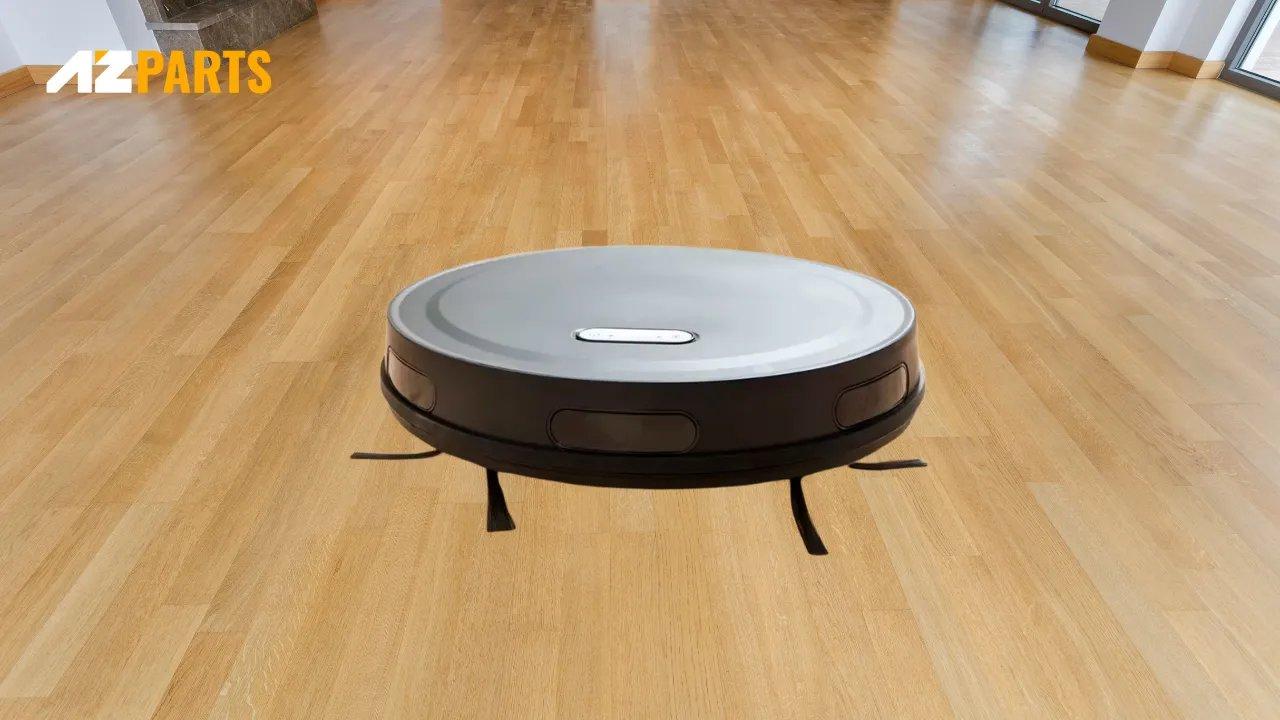
1. How Do Robot Vacuums Work?
A robot vacuum cleaner is an autonomous device using a combination of sensors, motors, brushes, and smart technology to navigate and clean your home efficiently. They are designed to operate independently, detecting obstacles, mapping their surroundings, and performing cleaning tasks with minimal human intervention. Once their job is done, they automatically return to their docking station to recharge and get ready for the next session. Below are the key components that make this possible:
- Motor: The motor serves as the heart of the robot vacuum. It generates powerful suction to pull in dust, dirt, and debris from all types of flooring. This includes particles hidden in corners, crevices, and carpet fibers.
- Brushes: Robot vacuums use a combination of roller and side brushes to lift and collect dirt effectively. Roller brushes are ideal for deep cleaning and preventing hair tangles, while side brushes help sweep dust and debris into the vacuum’s suction path, especially along walls and in tight spaces.
- Battery: These vacuums run on rechargeable batteries, allowing for cordless operation. When the battery is low, the vacuum automatically returns to its docking station to recharge.
- Docking Station: The docking station is the robot’s base, where it charges between cleaning sessions. Advanced docking stations may also empty the dustbin, clean mop pads, and refill the water tank to prepare the vacuum for the next round of cleaning.
- Mop Function: Some robot vacuums come with a built-in mop feature, allowing them to vacuum and mop in a single session. This dual function helps save time and effort. For efficient mopping, many users choose compatible vacuum mop pads, which are designed for optimal stain removal and long-lasting use.
- Sensors: Modern robot vacuums rely on various sensors to move and clean intelligently. Navigation sensors, such as laser or infrared systems, help create a virtual map of your home and plan efficient routes. Obstacle sensors detect furniture, cords, and other objects to avoid collisions, while cliff sensors prevent the vacuum from falling down stairs or ledges by detecting sudden drops.
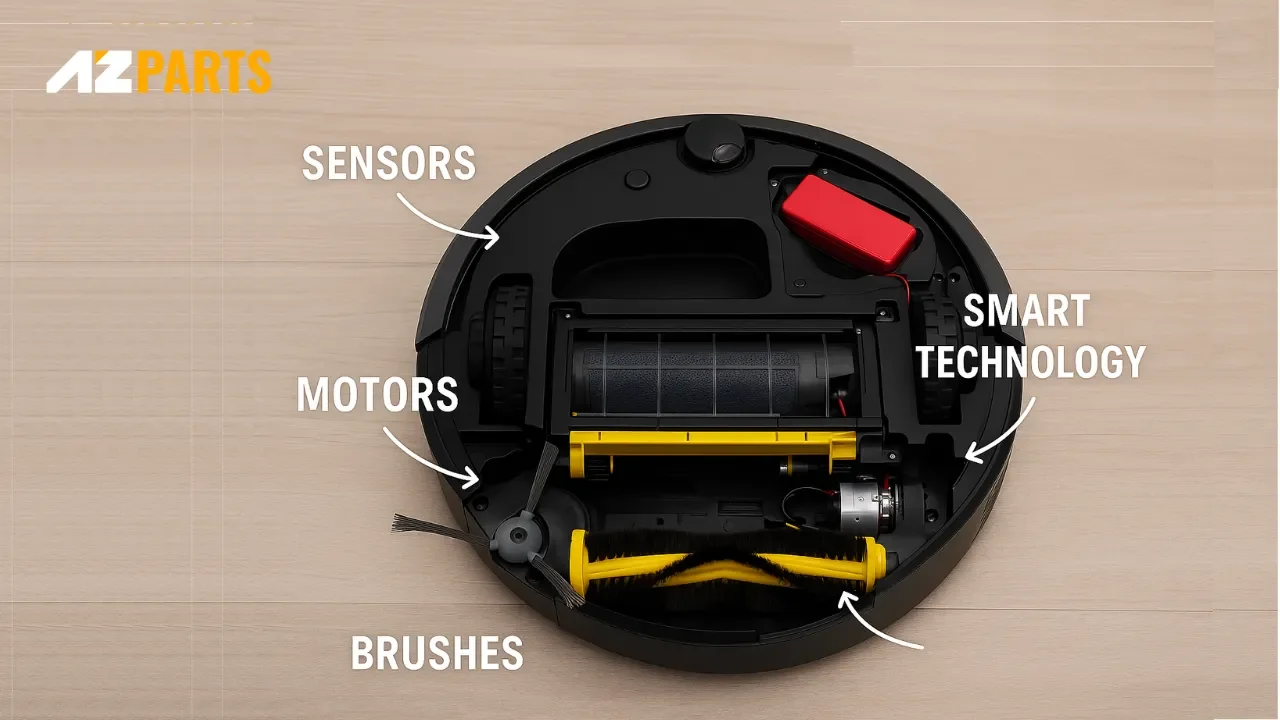
Robot vacuum cleaners use a combination of sensors, motors, brushes, and smart technology (Source: AZParts)
2. Navigation Technology Explained
Modern robot vacuums are equipped with advanced navigation systems that allow them to clean with precision and efficiency. Unlike earlier models that moved randomly and often missed spots, today’s smart vacuums use a combination of sensors, algorithms, and real-time data to create organized cleaning routes and avoid obstacles. Below are the core technologies that power their intelligent navigation:
- Sensors and Mapping: Robot vacuums rely on a range of sensors to understand their surroundings. Infrared sensors detect nearby objects to help the vacuum avoid collisions. Laser-based sensors, such as LiDAR, scan the room to build accurate floor maps, while camera sensors capture visual information to recognize and steer around obstacles. These sensor inputs are essential for creating a detailed virtual map of the cleaning area.
- SLAM Algorithm: This algorithm processes real-time data from the sensors to determine the robot's position while simultaneously building a map of the space. It enables the vacuum to navigate in a logical pattern, cover the entire floor efficiently, and remember areas it has already cleaned.
- Obstacle Avoidance: Robot vacuums can detect and avoid obstacles such as furniture, toys, cords, and even pets while cleaning. Advanced models use structured light technology or 3D scanning, like DEEBOT’s TrueDetect 3D, to identify objects with high precision. This prevents collisions and ensures a smooth and thorough cleaning experience.
- Docking Station: The docking station serves as a home base and plays an important role in navigation. When the battery runs low, the vacuum returns to the docking station automatically for recharging. After recharging, it can continue cleaning exactly where it left off, thanks to its memory and mapping capabilities.
- Real-time Route Planning: As the robot vacuum moves around the home, it continuously analyzes its surroundings and adjusts its path in real time. This allows it to respond to unexpected changes, such as a new obstacle in the room, and to clean in the most efficient pattern without repeating areas.
- App Mapping Interface: Most modern robot vacuums connect to a mobile app, which displays a visual map of your home. Through the app, users can schedule cleaning, set no-go zones, and even direct the vacuum to clean a specific room or spot with just a tap. This interface makes managing and customizing the cleaning process simple and convenient.
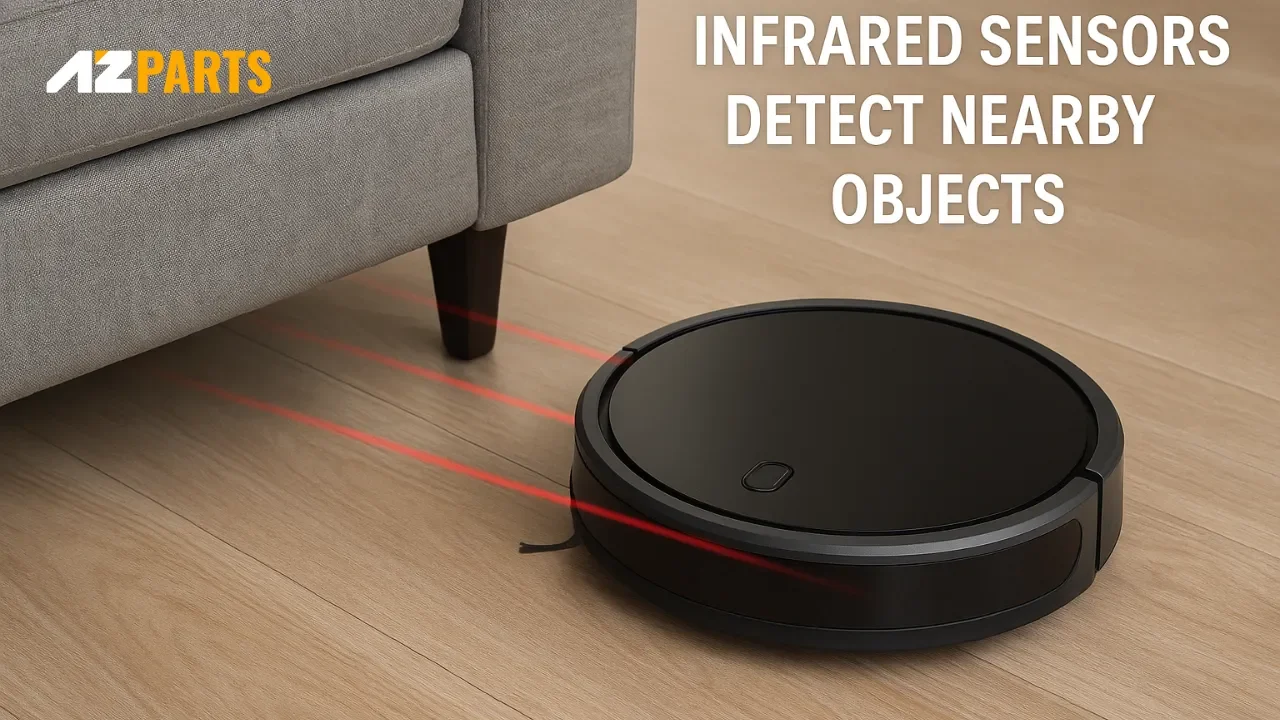
Infrared sensors detect nearby objects to help the vacuum avoid collisions (Source: AZParts)
3. Cleaning Features That Power the Performance
The cleaning power of robot vacuums depends on a combination of advanced technologies and thoughtful design features. From powerful suction to intelligent surface detection, these machines are built to handle a wide range of cleaning tasks with minimal effort from the user. Here are the key cleaning features that enhance their overall performance:
- Suction Power: Suction strength is one of the most important factors in cleaning performance. It is usually measured in Pascals, and a higher number means the vacuum can pick up more dirt and debris. Strong suction is especially useful for carpets, where dust and hair can become deeply embedded.
- Brushes: Brushes help loosen and lift dirt so it can be easily vacuumed. Most robot vacuums use a combination of roller brushes and side brushes to reach into corners and along edges. A quality vacuum roller brush improves overall cleaning efficiency by preventing hair tangles and improving dirt collection on different surfaces.
- Mopping System: Many robot vacuums now include a built-in mopping feature to tackle both dry and wet messes. These systems apply even pressure to remove stains and can adjust water usage based on floor type.
- Object Recognition and Learning: Smart object recognition allows the robot to distinguish between dirt and common household items such as cables, shoes, and pet waste. Advanced models use artificial intelligence to improve their awareness over time, learning how to navigate around new obstacles more effectively with each use.
- Surface Detection: Robot vacuums can detect the type of surface they are cleaning and adjust their settings accordingly. On hard floors, they may reduce suction and activate mopping. On carpets, they increase suction power to remove deep-set debris while avoiding water application to keep the surface dry and clean.
- Pet Mode: Pet Mode is designed for homes with animals. It enables the vacuum to clean efficiently without disturbing pets or their accessories. Some models can even detect pet presence and clean around them with extra care. Introducing the vacuum in a quiet mode can help pets adjust to the machine without stress.
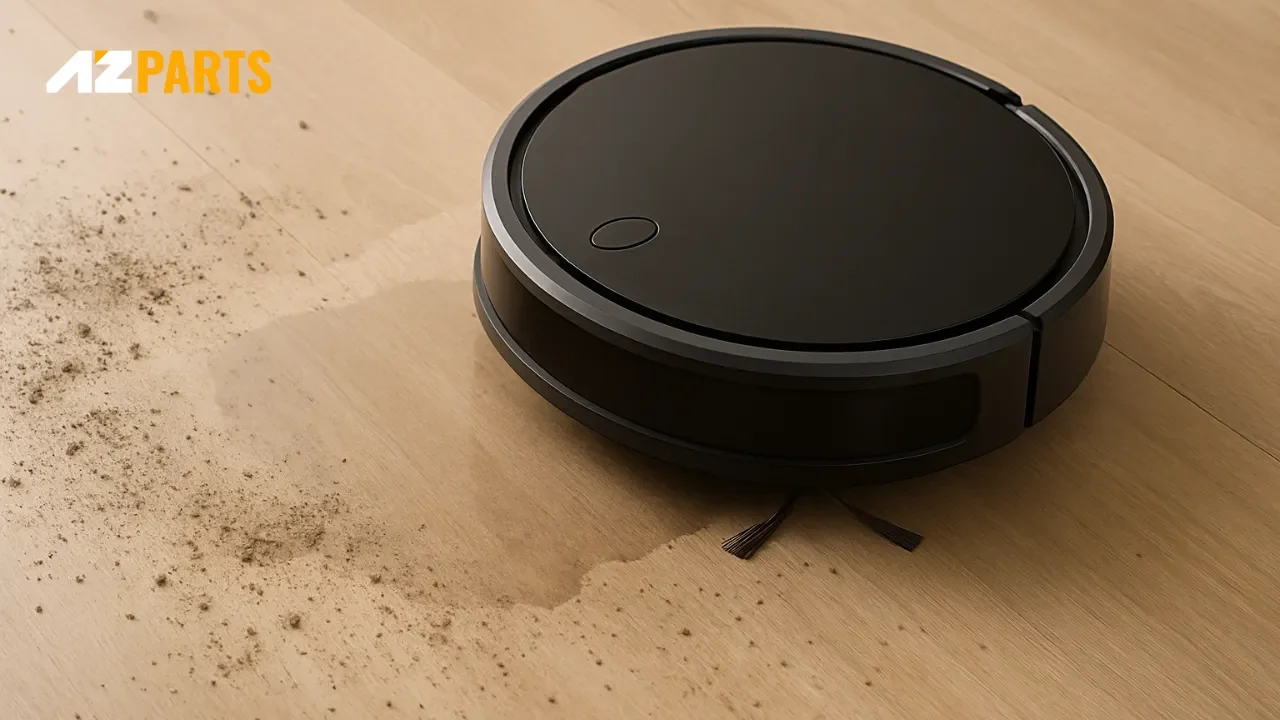
Smart object recognition allows the robot to distinguish between dirt and common household (Source: AZParts)
4. Smart Features That Simplify Cleaning
Modern robot vacuums are designed to make cleaning more convenient and hands-free than ever before. With the help of smart technology, these devices allow users to manage cleaning tasks remotely, integrate with smart home systems, and receive helpful reminders and updates. These features enhance both comfort and control, especially for busy individuals, elderly users, or those with mobility challenges.
- Remote Control via App or Buttons: Robot vacuums can be operated using either onboard control buttons or a mobile app. Through the app, users can start or stop cleaning sessions, schedule cleanings, select specific rooms to clean, or set up no-go zones. Even when away from home, you can monitor and control the vacuum with just a few taps on your phone. Some models also support voice commands for even easier control.
- Smart Home Integration: Many robot vacuums can connect to smart home systems like Amazon Alexa or Google Home. This allows users to control their vacuum with simple voice commands, such as “Start cleaning the living room.” Smart home integration adds convenience for those who may prefer voice interaction over mobile apps.
- Scheduling Options: With built-in scheduling features, users can automate cleaning sessions based on daily routines. For example, the robot can be set to clean every morning after you leave for work or at night while you sleep.
- Cleaning Reminders via Mobile App: The mobile app also provides helpful notifications and reminders, such as when it is time to clean the dustbin, replace vacuum filters, or check the mop pads. These alerts help maintain the vacuum’s performance and extend its lifespan without users needing to track maintenance manually.
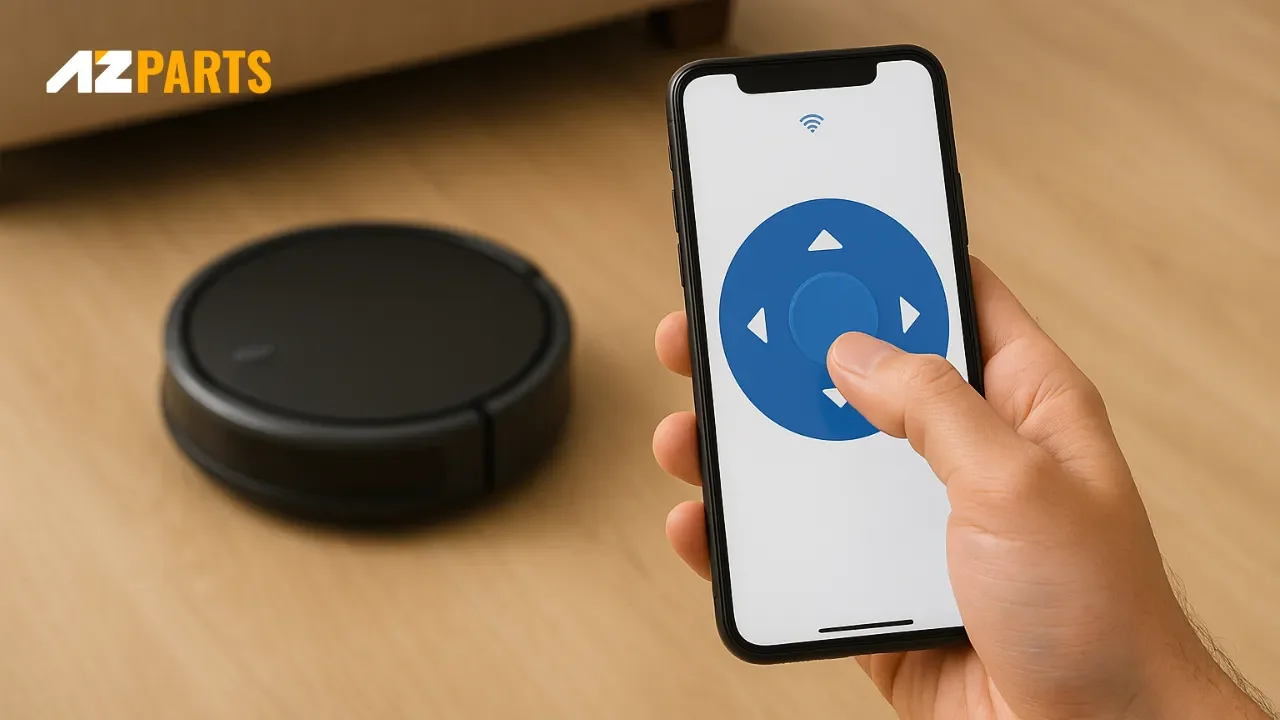
Robot vacuums can be operated using either onboard control buttons or a mobile app (Source: AZParts)
5. Setting Up a Robot Vacuum
Setting up a robot vacuum for the first time is simple and straightforward. By following a few basic steps, you can ensure the vacuum is ready to clean efficiently and according to your preferences. From charging the device to customizing its schedule, each step plays an important role in getting the most out of your robot vacuum.
- Step 1: Fully Charge the Vacuum
Before using the robot vacuum for the first time, make sure it is fully charged. Place it on the docking station and allow it to charge completely. A full charge ensures that the vacuum has enough power to perform its initial mapping and cleaning tasks effectively.
- Step 2: Install and Connect the App
Download the compatible mobile app on your smartphone or tablet. Follow the setup instructions provided in the app to pair your robot vacuum with your device. The app allows you to control and customize cleaning settings easily.
- Step 3: Connect to Wi-Fi
Connect the robot vacuum to your home Wi-Fi network. This connection is necessary for the vacuum to communicate with the app, receive software updates, and access features like remote control and scheduling.
- Step 4: Start the Mapping Process
Once connected, begin the initial mapping process. Allow the robot vacuum to scan and map your home without interruption. During this time, avoid moving or picking up the vacuum, as this could disrupt its ability to remember and navigate the space accurately.
- Step 5: Set Up Cleaning Schedule and Preferences
Use the app to create a cleaning schedule that suits your lifestyle. You can choose the frequency, time of day, and specific areas to clean. For better performance and convenience, consider using a robot vacuum kit from AZParts, which includes essential accessories to maintain and enhance your device over time.
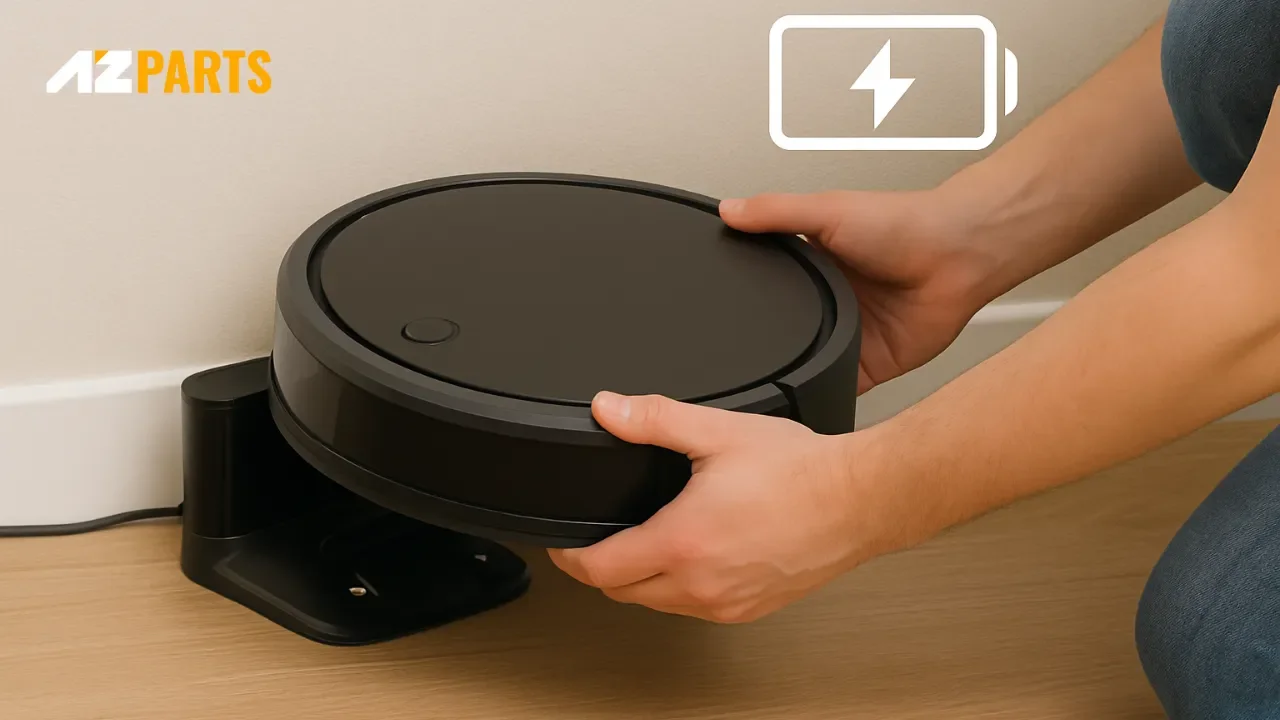
Before using the robot vacuum for the first time, make sure it is fully charged (Source: AZParts)
Robot vacuums are more than just a high-tech convenience, they’re a smart investment in daily comfort and home hygiene. Now that you understand how do robot vacuums work, you can choose the right model and keep it running smoothly with the right accessories. For trusted vacuum replacement parts like mop pads, roller brushes, and vacuum kits, visit AZParts and give your vacuum the upgrade it deserves.
Contact Info
Address: 8 The Green, Ste A, Dover, Delaware 19901-3618, United States
Email: support@azparts.com
Vacuum
Further Reading
Further Reading





